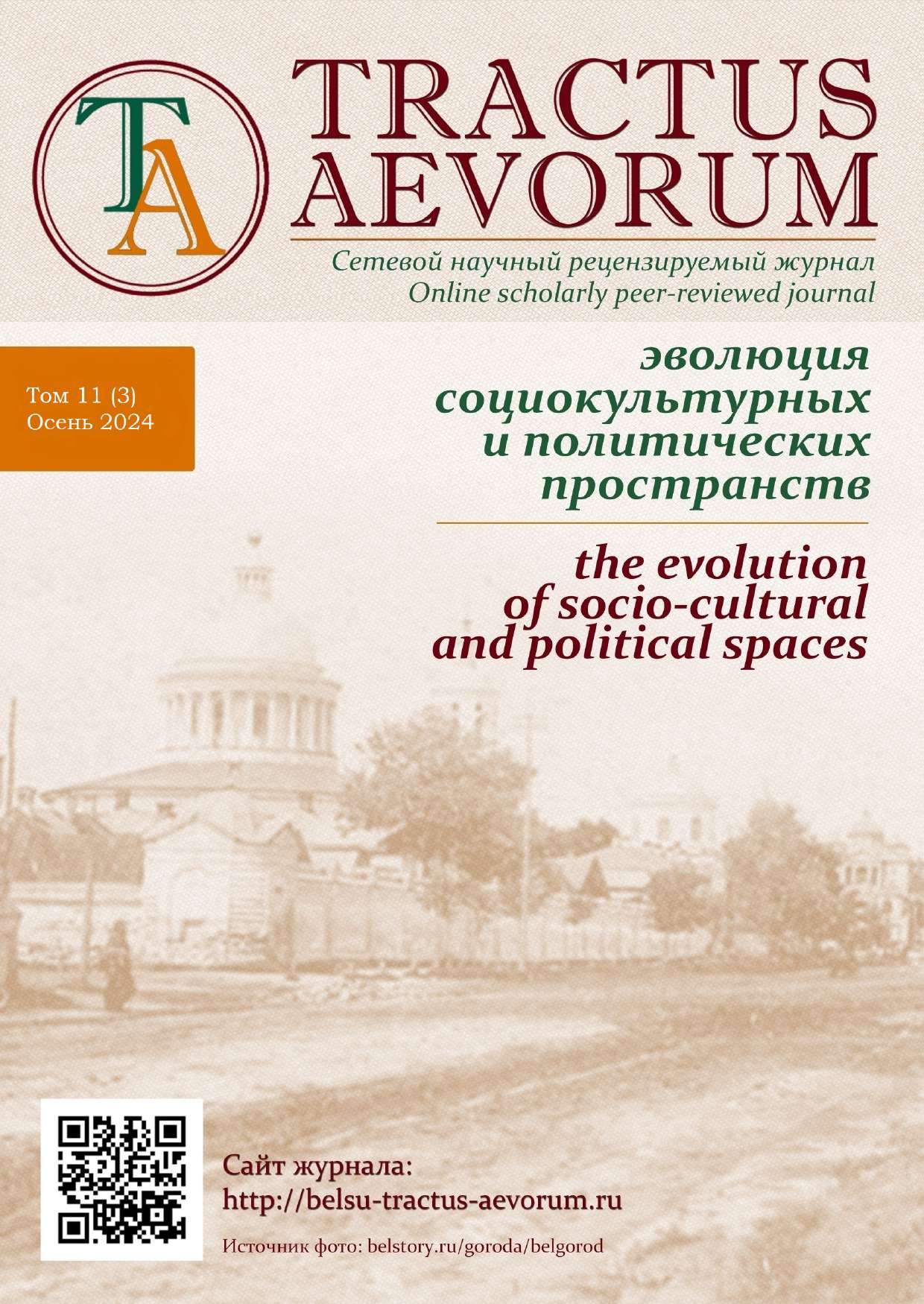|
FAMILY AND FAMILY VALUES IN HISTORICAL RETROSPECTIVE
|
Marriage and Family Legislation of August in Literary and Historical Sources of the 1st Century B.C. – 2nd Century A.D.
|
  |
Original article
Anastasia А. Kolotushkina
OGBU “Belgorod Information Fund”
4, Sobornaya Square, Belgorod, 308005, Russia
E-mail:
This e-mail address is being protected from spambots. You need JavaScript enabled to view it
Abstract. Based on literary and historical-biographical works, the article considers the manifestations of the crisis of the institute of family and marriage in the Roman society of 1st century B.C. - 2nd century A.D., methods of legislative settlement of problems in the system of family relations, adopted by Emperor Augustus, and the subsequent reaction of society to the adopted laws. The author investigates the personal position of poets and historians with regard to Octavian's policy in the field of private life of Romans, identifies the main reasons for the degradation of moral and ethical norms in the society of the presented period. Investigating numerous attempts to circumvent Julian laws on the part of Roman citizens, as well as the deterioration of family and marriage relations, reflected in written sources, the author comes to the conclusion about the lack of effectiveness of Augustus' laws in the sphere of family and marriage.
Keywords: principate, Octavian Augustus, Roman family, marriage, spouses, children, degradation of morals, Horace, Ovid, Marcial, Plutarch, Tacitus, Suetonius, marriage and family legislation.
DOI: 10.18413/2312-3044-2024-11-3-202-213
PEOPLE ON DUTY
|
The Gallo-Roman Aristocracy in the Service of the Barbarians: on the History of the Commander Eunius Mummolus
|
  |
Original article
Kirill A. Vladimirov
Belgorod State National Research University
85 Pobedy st, Belgorod, 308007, Russia
E-mail:
This e-mail address is being protected from spambots. You need JavaScript enabled to view it
Abstract. The article analyzes the life and career of Eunius Mummolus, a native of a Gallo-Roman family, famous for his generalship and participation in the speech of Gundowald. The main source of Mummol's biography is the "History of the Franks" by Gregory of Tours. The example of Eunius shows that career opportunities for Gallo-Romans were not limited to church service – the most famous because of the large number of sources of the "survival strategy" in post-Roman Gaul. In turn, the Frankish monarchs not only attracted the local nobility to govern, but also tried to follow the late Roman traditions.
Keywords: Late Antiquity, Gaul, Eunius Mummolus, Gundowald, Franks, Gallo-Romans.
DOI: 10.18413/2312-3044-2024-11-3-214-226
|
S. Milchert’s Service in Russia as a Cultural Transfer Phenomenon
|
  |
Original article
Yevgenia М. Lupanova
Peter the Great’s Museum for Anthropology and Ethnography (Кunstkamerа) Russian Academy of Sciences
3 Universiteskaya emb., St. Petersburg, 199034, Russia
E-mail:
This e-mail address is being protected from spambots. You need JavaScript enabled to view it
Abstract. The biography of forstmeister S. Milchert in Russian service is a vivid example of the transformation of borrowed Western-European experience in Russian conditions. Initially invited to perform tasks that appeared as a result of an active modernization and in connection with the need of building modern battleships, a few years later he began to perform purely traditional tasks of providing monarch hunting.
Keywords: Russian modernization, transfer, sailing ship-building, forestry, royal hunt, Izmailovsky menagerie.
Acknowledgements: The author expresses her appreciation to Sergey A. Milchert, a descendant of the main character of the article, for the assistance in formulating the research task and searching for materials.
DOI: 10.18413/2312-3044-2024-11-3-227-237
|
Activities of N.I. Bulanov as City Head of the Stavropol City Duma
|
  |
Original article
Daria V. Kuznetsova
Tolyatti State University
14 Belorusskaya st, Tolyatti, 445020, Russia
E-mail:
This e-mail address is being protected from spambots. You need JavaScript enabled to view it
Nadezhda M. Rumyantseva
Tolyatti State University
14 Belorusskaya st, Tolyatti, 445020, Russia
E-mail:
This e-mail address is being protected from spambots. You need JavaScript enabled to view it
Abstract. In 1873, the City Duma was established in Stavropol (now Tolyatti) as the highest body of local government. It was in charge of various issues: the formation of the external appearance of the city, the organization of cultural events, the development of education and healthcare. The functioning of the local government system remains one of the main issues today. Having studied this problem, it can be noted that, based on the accumulated experience, there is a transformation of the relationship between the government and the heads of local government. The authors made an attempt to address the history of the Stavropol City Duma of the 19th century and analyze one of the key figures in the system of self-government – the city Mayor, who occupied a fairly high status due to the concentration of both legislative and executive power in his hands. The focus of the study is on the activities of the City Head of the Stavropol Duma, Nikolai Ivanovich Bulanov, who was born into a merchant family and was able to receive a higher education, which made him very different from his fellow officers. Nikolai Bulanov worked for more than 30 years in the Stavropol city government and during this time made a significant contribution to the development of city infrastructure. The source base is includes materials from the Tolyatti archive: journals of City Duma meetings on issues of city improvement, formal lists, ballot papers for city mayor election, reports of city councils.
Keywords: Stavropol City Duma, city government, local government figures, post-reform city, city head, city councilor, improvement, education, cultural space, social infrastructure.
DOI: 10.18413/2312-3044-2024-11-3-238-254
TRANSITIONAL EPOCHS
|
The origins of political eschatology in Europe: The French Revolution as a cosmic struggle of good and evil forces
|
  |
Original article
Tony Rocchi
Former researcher at the Reference Library,
Independent researcher
Toronto, Canada
E-mail:
This e-mail address is being protected from spambots. You need JavaScript enabled to view it
Abstract. Eschatology is a religious doctrine about the coming end of the world and the coming of a new age. Beginning in the late 18th century, eschatology acquired a political content and was used often by many European ideologies, especially nationalism and socialism, to explain the course of history. Revolutions often included an eschatological content. The French Revolution was the first major European revolution with a large eschatological content. This article examines the influence of eschatology on the course of this revolution. The eschatological tendencies, begun in the French and other revolutions, culminated in the Russian Revolution of 1917-1922. These tendencies included dividing people into categories of the saved and condemned, demonization of enemies, especially internal ones, conspiracy theories, compiling criteria for membership in a political or ethnic nation, determining norms of correct behavior for members of the nation, compiling criteria for the exclusion of people from the ranks of the nation. The article theme has a certain relevance to contemporary outbreaks of political and religious eschatology in different movements and ideologies.
Keywords: French Revolution, European revolutions, political eschatology, Christian eschatology.
DOI: 10.18413/2312-3044-2024-11-3-255-287
|
Soviet-Bulgarian and Russian-Bulgarian economic and socio-cultural interaction in the Belgorod region in the last third of the 20th century
|
  |
Original article
Alexander A. Pchelinov-Obrazumov
Regional State Government Institution
«State Archive of the Belgorod region»
(RSGI «SABO»)
14 Mokrousova st., Belgorod, 308024, Russia
E-mail:
This e-mail address is being protected from spambots. You need JavaScript enabled to view it
Nikolay N. Fomichev
Regional State Government Institution
«State Archive of the Belgorod region»
(RSGI «SABO»)
14 Mokrousova st., Belgorod, 308024, Russia
E-mail:
This e-mail address is being protected from spambots. You need JavaScript enabled to view it
Abstract. This article deals with the problem of economic and socio-cultural cooperation between the Belgorod region and Bulgaria. Bulgarian builders and workers have made a significant contribution to the formation of the modern industrial structure of the region. We have analyzed five funds of the State Archive of Belgorod region on Soviet-Bulgarian and Russian-Bulgarian cooperation for the specified period. The relations between Belgorod region and Bulgaria in the 1960-s and 1980-s became an important part of the interstate interaction between Bulgaria and the USSR. They also developed in the 1990s already in the context of the changed political and economic situation in both countries.
Keywords: Bulgaria, Belgorod Region, «Lebedinsky Mining and Processing Plant», «Stoilensky Mining and Processing Plant», «Tsentrotyazhstroy», «Energomash», «KMAruda».
DOI: 10.18413/2312-3044-2024-11-3-288-302
|



